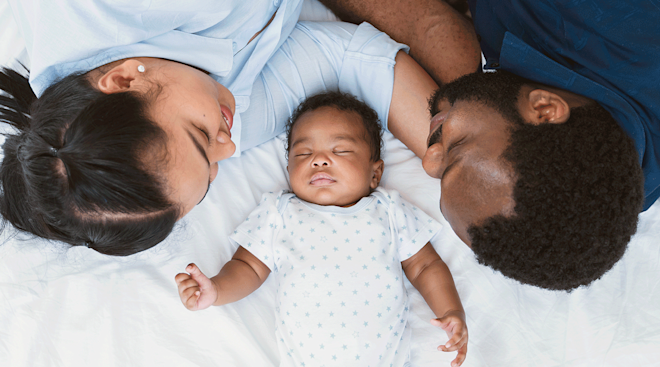10 Ways You Can Make Sure Baby Is Sleeping Safely
It’s a beautiful thing when baby drifts off to sleep—but when your new-mom paranoia kicks in, you might find yourself constantly checking on your infant to make sure they’re still breathing. And it’s not a wholly unreasonable concern: According to the US Centers for Disease Control and Prevention, there are about 3,500 sleep-related deaths among US babies each year. Luckily, experts have figured out a few easy things parents can do to help ensure safe sleep for babies. Here are the top 10 tips from the American Academy of Pediatrics (AAP) to keep baby safe and sound while they sleep.
Step one in ensuring crib safety: Whether you’re using a crib, portable crib, bassinet or play yard, check that it meets the safety standards set by the Consumer Product Safety Commission (CPSC). When you were a baby, your parents may have used a crib with a drop railing, but the CPSC has banned that type of crib since 2012, after finding that cribs with sides that lowered put babies at significant risk of suffocation and strangulation.
Adults may enjoy their pillow top mattresses, but babies should always sleep on a firm surface—meaning a hard surface that doesn’t indent when they’re lying on it. That could be a type of crib, bassinet or play yard with a firm mattress and a tight fitted sheet designed specifically for that product. You also don’t want any large gaps between the mattress and sides of the crib; when a mattress is fitting properly, you shouldn’t be able to slip more than two fingers down the sides.
It doesn’t matter if you’re putting your child down for a nap or for the night—always place baby to sleep on their back, not their stomach. This is one of the most important tips for safe sleep for infants. Generations past put their infants on their tummies, thinking they might otherwise choke on their spit-up, but the AAP reassures that baby’s airway anatomy and gag reflex will prevent that from happening. Even babies with reflux should be placed on their backs. Why? Because research shows infants who sleep on their backs have better airflow and are much less likely to die of Sudden Infant Death Syndrome (SIDS) than babies who sleep on their stomachs or sides—a position from which babies can easily roll onto their tummies.
As babies gets older, they may start rolling onto their bellies overnight. “If baby is comfortable rolling both ways (back to tummy, tummy to back), then you don’t have to return baby to their back if they roll over on their own,” says Cara Dumaplin, a neonatal nurse and the founder of Taking Cara Babies, which offers sleep classes and resources—like this handy safe sleep checklist—for parents of babies and toddlers. “It’s important that your little one’s arms are free (not swaddled) for tummy sleep.” Note, though, that even though you don’t have to get up and turn baby over if they can roll on their own, you should still always put baby on their back at bedtime until your child is at least 1 year old.
Other than the mattress, fitted sheet and your child, there should be nothing in the crib while baby sleeps. That means no blankets, pillows, toys or crib bumper pads. Sure, your nursery photos might look extra-cute with a quilt draped over the crib rail and a plush bear tucked into the corner, but when it’s time for baby to go to sleep, these items can put your little one at risk of suffocation, strangulation and entrapment and should all be removed. If you’re worried about baby getting cold, it’s safe to use a wearable blanket—a fabric sack, with or without arms, that you can zip your child into, eliminating the risk of their face getting covered by loose bedding.
The AAP also doesn’t recommend using positional sleep devices in baby’s crib, since they can be a suffocation hazard. “Occasionally parents feel positioning devices are best because their little ones suffer from reflux—but please know: Research demonstrates that even babies with reflux are safest flat on their backs for sleep,” Dumaplin says. (Worried baby won’t sleep well without one? Check out Taking Cara Babies’ tips for how to wean off baby sleep products.)
While giving your child a pacifier is by no means required (after all, there are some pros and cons), one of the huge benefits is that it’s been shown to reduce the risk of SIDS, even if the pacifier falls out of baby’s mouth after they’re asleep. If you’re breastfeeding, the AAP recommends waiting until you and baby have the hang of it (usually two to three weeks) before introducing the pacifier. And if your child simply doesn’t like sucking on a paci, don’t sweat it.
Not all babies enjoy being swaddled—aka, being wrapped up burrito-style—but if yours does, know that the AAP deems it safe to put baby to sleep in a swaddle. Which is great news, given that swaddling, which mimics the snugness of the womb, can help babies sleep more soundly. Just make sure you’re swaddling baby properly. “I always recommend a swaddle that zips or velcros, since they’re less likely to become loose bedding in the crib compared with just a traditional blanket,” says the Taking Cara Babies founder. Always place your swaddled baby on their back, and ensure they aren’t swaddled so tightly that they can’t move their hips around or breathe easily. “Even with a snug swaddle, parents want to be able to slip a hand between the swaddle and baby’s chest to allow for deep breaths,” Dumaplin cautions.
As soon as you spot baby breaking free or trying to roll over, it’s time to ditch the swaddle, since you don’t want your child to sleep with loose blankets or roll onto their belly and not be able to return to their back.
To help ensure safe sleep, remove any window cords or electrical wires—including your baby monitor wires—that hang near baby’s crib, since your little one could get tangled in them and choke.
It’s natural to want to make sure baby is toasty warm overnight, but studies show sleeping in a hot room actually increases the risk of SIDS by around 4.5 percent. For best safe sleep practices, set baby’s room temperature between 68 and 72 degrees Fahrenheit to keep baby comfy and safe.
Of course, those are general guidelines. But instead of obsessing over the thermostat, Dumaplin recommends dressing baby in layers similar to your own and then assessing. “If you’re wearing a T-shirt and using a sheet, baby will likely be comfortable in a onesie and a lightweight swaddle,” she says. “If you’re in heavy pajamas under a comforter, dress baby in thick pajamas and a warm sleep sack and then assess your child.” To gauge whether baby is comfortable, touch their back and chest—it should feel warm, not cool, Dumaplin says. If you see sweaty hair, a flushed face or rapid breathing, those are signs that baby is too warm and needs to shed a layer. If they’re too cold, add an undershirt, heavier pajamas or a warmer sleep sack—but remember, stay away from loose blankets in the crib. (Want more tips on dressing baby for sleep? Taking Cara Babies has a few.)
An easy way to reduce baby’s risk of SIDS—by a whopping 50 percent, according to the AAP—is to place baby’s sleep area in your own bedroom for at least the first six month, ideally up to a year. Place the crib, bassinet or play yard close to your bed. It’ll make it easier for you to feed, comfort and keep an careful eye on baby.
While the AAP and CDC are proponents of room-sharing, they’re decidedly against bed-sharing, saying it puts baby at a higher risk for sleep-related death. After you’ve finished nursing or soothing your little one, place baby back in their own sleep space. Of course, plenty of new moms are battling exhaustion, so if there’s a chance you might fall asleep with baby still in your bed, the AAP recommends making sure there are no pillows, sheets, blankets or other items that could cover your child’s face and head or cause them to overheat. As soon as you wake up, move baby back to their own bed.
Updated March 2020
Please note: The Bump and the materials and information it contains are not intended to, and do not constitute, medical or other health advice or diagnosis and should not be used as such. You should always consult with a qualified physician or health professional about your specific circumstances.
Plus, more from The Bump:
Navigate forward to interact with the calendar and select a date. Press the question mark key to get the keyboard shortcuts for changing dates.





















































